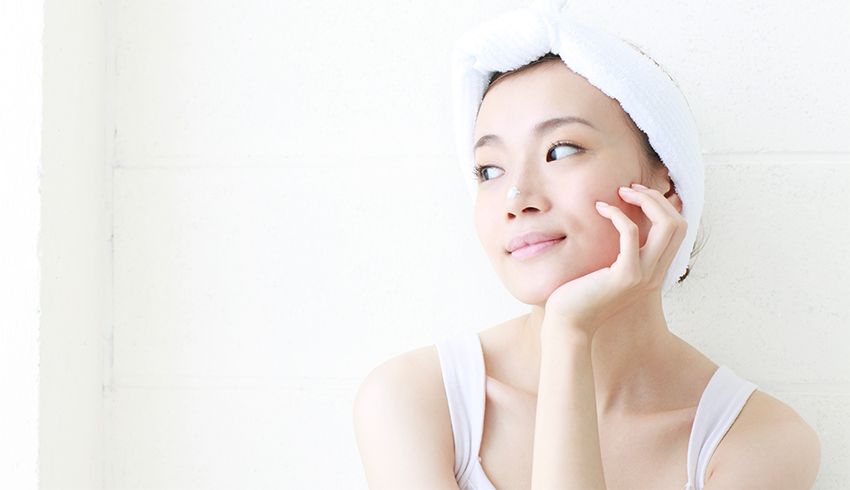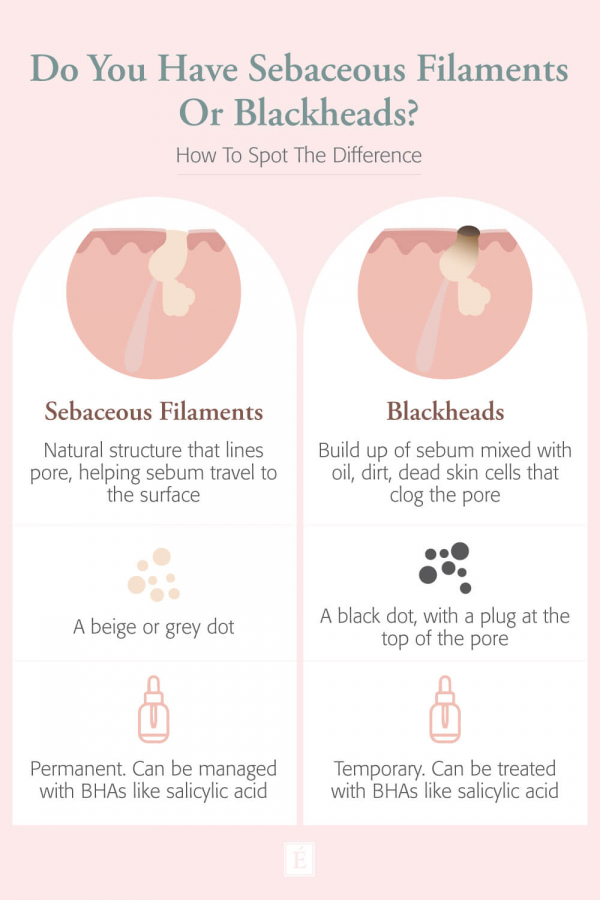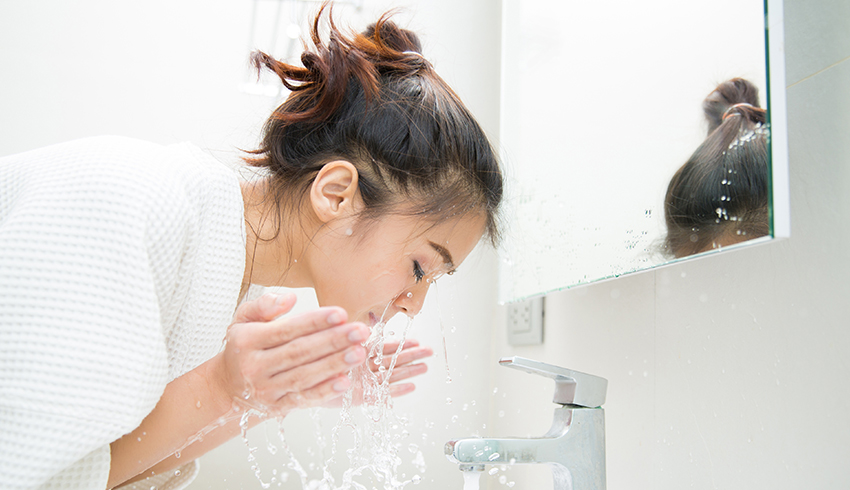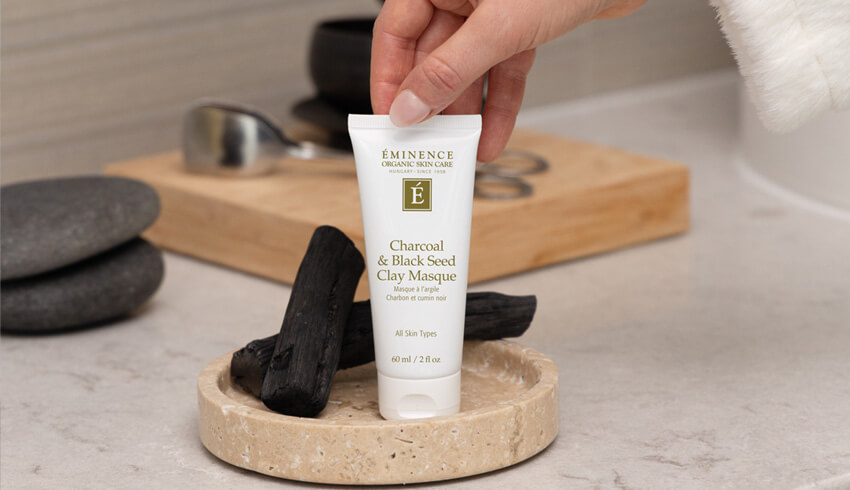
If you’ve ever suffered a smattering of blackheads that just don’t clear away, take a closer look. You might not be dealing with blackheads at all, but sebaceous filaments instead. While often mistaken for blackheads, sebaceous filaments are a different animal altogether. Learn all about what separates these spots, how to identify whether you’re dealing with them and which treatments and ingredients are best to manage them.
Key Takewaways: Blackheads & Sebaceous Filaments
- What Are Blackheads: Blackheads are raised, black or dark brown bumps caused by clogged pores filled with oil and debris that oxidize upon exposure to air.
- What Are Sebaceous Filaments: Sebaceous filaments are normal skin structures that help transport oil to the surface; unlike blackheads, they are not a type of acne and do not need to be removed.
- How To Treat Them: Managing blackheads involves gentle exfoliation, salicylic acid and clay masks, while sebaceous filaments benefit from routine cleansing and non-comedogenic products.
Blackheads vs. Sebaceous Filaments: What's the Difference?
Blackheads and sebaceous filaments are often confused for one another but they are not the same. Both appear as dark specks on your skin — especially on and around the nose and chin — and both look like pores. So what's the difference?
Blackheads are a type of acne. They are bumps on the surface of the skin that fill up with excess oil, dead skin and pollutants from the environment. In a blackhead, a plug of sebum is at the surface of the skin and prevents oil from traveling through the pore. They appear black and are often raised above the skin.
Sebaceous filaments, on the other hand, are structures that line the pore to carry sebum through the hair follicle to the surface of the skin. This is a good thing. They help keep the skin moisturized and lubricated. They are not always visible, but when they are, they appear lighter, usually a shade of grey or beige and exist below or flush with the skin.

What Are Blackheads?
As mentioned above, blackheads are a type of acne that shows up when sebum comingles with oil, dirt and dead skin cells to clog a pore. They appear as a black dot (hence the name) due to a chemical reaction called oxidation. When the pore-clogging “ingredients” are exposed to the air, that reaction turns that gunk black. It’s important to note that the black color of a blackhead is not dirt, but rather the result of a chemical reaction.
What Causes Blackheads?
If sebaceous filaments are simply a function of the skin, and only visible when someone has excessive sebum production or larger pores, what causes blackheads? Blackheads can be caused by five main factors:
1. Environment: In an environment with pollution and/or poor circulation, you are exposed to a greater amount of particulate matter in the air. This dirt and dust settles on the skin making its way into open pores where these impurities clog the skin.
2. Excess Oil: The oil or sebum found inside of pores is sticky. Especially if you have an oily skin type, this will combine with pollutants, creating a sludge that gets stuck inside the pore.
3. Diet: Sometimes dietary changes, restrictions or sensitivities can cause the skin to produce more or less oil. More oil production will add to the stickiness that clogs pores, while less oil can lead to a dry, tight pore that lacks the flexibility to be cleaned out properly.
4. Hormones: Hormonal changes can also contribute to excessive oil and sebum production, leading to clogged pores, blackheads and acne. While breakouts sometimes clear once hormones settle, blackheads are less likely to fade.
5. Medication: Lastly, just like with diet, medication can drastically change your skin’s oil production. You may see the skin become more greasy and clogged, or the area around the pore become tight and shiny, both of which aggravate blackheads.
How To Improve the Appearance of Blackheads
If you think you are dealing with blackheads and not sebaceous filaments, our first recommendation is to see an esthetician at your nearest Eminence Organics Spa Partner to confirm which dark spots you’re dealing with. Unlike sebaceous filaments (which do not need to be removed), blackheads should only be extracted by an esthetician. No picking or squeezing your skin at home!
Soften Pore Congestion
To help minimize the appearance of blackheads, our Lead Skin Care Trainer, Natalie Pergar, recommends our Stone Crop Oxygenating Fizzofoliant. Thanks to the adzuki powder in this exfoliant, the debris inside the pore will be softened and easier to clear out through face wash, and excess oil will be absorbed. A few shakes of this powder can be mixed into your favorite cleanser, blending with a few drops of water. Oily skin types can use this concoction daily, while normal to dry skin types should opt for two to three times per week.
Use a Spot Treatment
Try our Acne Advanced Clarifying Masque designed to prevent future breakouts and restore clarity to your skin. It is formulated with basil oil, beta hydroxy acid and three types of clay to deliver protection against breakouts by encouraging exfoliation and unclogging pores. To use, simply apply a small amount of product evenly over the entire face and neck. You can even apply to the spots directly, rather than the entire face. Allow the mask to dry for 5–10 minutes. Rinse thoroughly with lukewarm water and use a face cloth if desired.
Customize Your Moisturizer
Customization doesn’t need to stop with your weekly clay mask session. Personalize your daily moisturizer as well to ensure you’re delivering blackhead-busting ingredients while still hydrating the complexion. Natalie recommends blending or layering our Acne Advanced Clarifying Hydrator with our award-winning Bamboo Firming Fluid.
The Acne Advanced Clarifying Hydrator contains encapsulated salicylic acid to reduce oiliness and help shrink pores, without stripping the skin of moisture. The Bamboo Firming Fluid delivers lightweight hydration that will help create more flexibility along with helping diminish visible signs of aging. Natalie suggests that those with an oily skin type use two pumps of the hydrator with one pump of the fluid. With dry skin, you can use two pumps of the fluid with one pump of the hydrator.
The Best Ingredients for Treating Blackheads
Because blackheads develop when dead skin, oil and dirt and build up in the pore, ingredients that help mitigate buildup are your first line of defense.
Cleanse with salicylic acid. It breaks down the materials that clog pores, including excess oil and dead skin cells. It also works well to cleanse dirt, oil and makeup from the day.
Regular exfoliating can help remove excessive amounts of dead skin cells that can lead to clogged pores. The process may also gently remove existing blackheads. Both AHAs, like lactic acid and glycolic acid, and BHAs like salicylic acid are gentle enough to use on most skin types.
Clay masks are another weapon in the fight against blackheads. They draw oils and toxins out of the skin, which helps to unclog pores. Sulfur is a common ingredient in clay masks (including our Acne Advanced Clarifying Masque) and also works to break down the dead skin cells that make up blackheads.
Product Picks
What Are Sebaceous Filaments?
Unlike blackheads, sebaceous filaments are not a clogged hair follicle that needs to be cleared away. Rather, they are a completely normal function of the skin. As Dr. Lily Talakoub of McLean Dermatology and Skincare Center explained to us, “Sebaceous filaments are particles released from oil glands. Blackheads are oxidized keratin (produced by the squamous cells of the skin). Because they are open to the air, they oxidize and look black.”
Everyone has sebaceous filaments as they are found in every hair follicle on the skin! When visible, they do resemble blackheads, but are lighter, often appearing as tiny grey or beige spots that lay completely flat to the surface of the skin. As The Pretty Pimple points out: “Because sebaceous glands are highly concentrated around your nose and forehead, sebaceous filaments are more robust in these areas too.”
Who Do Sebaceous Filaments Affect?
Sebaceous filaments are a normal and healthy part of your skin. Everyone has them, but there are certain factors that may make them more noticeable:
- Age: Your sebaceous glands grow larger and create more oil around puberty, so your sebaceous filaments may be more apparent during those years. As you reach your 40s and 50s, your skin starts to sag or loosen. Your pores may start to get bigger, which makes your sebaceous filaments more obvious.
- Poor skin maintenance: If you spend too much time in the sun or wash your skin too much, you can dry out your complexion. Your sebaceous glands then work harder to produce more sebum and rehydrate your skin, which may cause them to look larger.
- Thicker hair: Thicker hair follicles make sebaceous filaments more visible.
How To Manage Sebaceous Filaments
While sebaceous filaments aren’t an issue the same way blackheads are, that doesn’t mean that you want to see them. While they shouldn’t be removed, and can’t be permanently eliminated, you can significantly reduce their appearance through consistent skin care practices and professional treatments.
“Chemical exfoliation through gentle fruit acids, gommage or microdermabrasion are the best methods ...” Dr. Lily Talakoub states. Not only is a professional facial a great starting point to improve the look of sebaceous filaments, but the esthetician can also recommend pore shrinking products to help manage their appearance on a daily basis. We recommend an Eminence Organics skin care routine that focuses on deep but gentle cleansing along with regular exfoliation.
Can You Get Rid of Sebaceous Filaments?
According to Cleveland Clinic, they can't be permanently removed (nor would you want that, as they play an important role in overall skin health). But if they bother you, there are a few things you can do to minimize the look:
- Wash your face daily with warm water and a mild facial BHA cleanser. Salicylic acid to the rescue again. It helps dissolve sebum and unclog pores, making them less noticeable.
- Routinely use moisturizer.
- Use non-comedogenic products and remove makeup at the end of each day.
- Keep your hands away from your face. Squeezing sebaceous filaments can irritate the skin and potentially lead to inflammation or scarring.
Product Picks
Watch Natalie Pergar explain the difference between sebaceous filaments and blackheads and how to treat them in the video below.
Frequently Asked Questions About Blackheads & Sebaceous Filaments
How can you tell the difference between blackheads on the nose vs. sebaceous filaments? While they both appear as dark spots on the T-zone, there are a few ways to differentiate between blackheads and sebaceous filaments. Blackheads tend to appear black in color, while sebaceous filaments show up as grey or beige. Blackheads are also often raised above the skin, appearing more as a bump. Sebaceous filaments, on the other hand, live below the skin and show up right on the surface.
Are sebaceous filaments harmful? Not only are they not harmful, sebaceous filaments actually serve a purpose in keeping the skin healthy. They are needed in order to carry sebum through the hair follicle to the surface of the skin, keeping skin moisturized and flexible. This is why we recommend minimizing the look of them (if they bother you) but not removing them.
Can sebaceous filaments turn into blackheads? Because the two are often confused, it’s a common misconception that sebaceous filaments can turn into blackheads. As mentioned above, blackheads are a form of acne. Sebaceous filaments are not acne; they are normal structures within the skin. Having said that, the overproduction of sebum that causes sebaceous filaments to fill up and become noticeable can also cause whiteheads or blackheads.
Do you think you’re dealing with blackheads, sebaceous filaments (or maybe both?) If you’re still not sure, visit your nearest Eminence Organics Spa Partner to help figure your your specific skin concerns and products that could help treat them.






